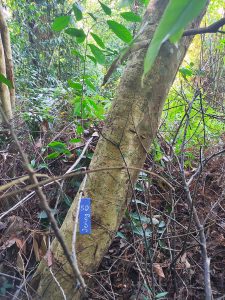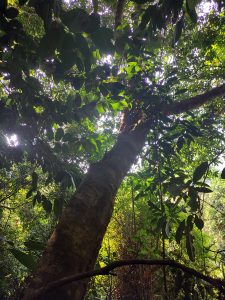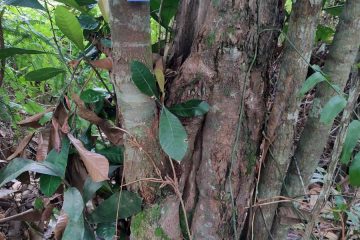50
Jering - Archidendron jiringa (Jack) I.C.Nielsen - Fabaceae [1]
Synonym:
Other names:
Jaring (Sabah) [1], Jengkol (Java) [2]
General information:
Distinguish botanical characteristics:
Leaf – alternate, bi-pinnate, leaflets – 2-3 pairs per pinna, opposite, ovate-elliptical to oblong, dark-violet red when young [2]
Inflorescence – axillary, paniculate, flower – greenish-white to cream-white [2]
Fruit – a legume, twisted in a wide spiral, lobed along the ventral suture between the seeds, dehiscent along the ventral suture, leathery, dull purplish brown when ripen [2,3]
Seed – compressed orbicular, yellow-green (young), turning dark brown [2]
Bark – smooth, grey or grey-white [3], inner bark – pink or reddish brown [4]
Heart wood – white with strong smell, sapwood – white or pinkish white [4]
Uses:
Leaves – the dark violet-red young shoots are eaten raw [2]
Seeds – edible – relished as local delicacy by the Malays, young seeds – eaten raw, mature seeds – need to be pre-prepared either boil thoroughly until the smell disappear, steep a few hours in salt water, buried in soil for 14 days until germinate before consume or cook [2], or pound and sun-dry [3]
Fruit shell – source of natural purple colour, used as shampoo [2]
Bark – used to dye mat into black by boiling in its water extract and then immersed in mud [2]
Wood – soft, suitable for cabinet work, interior joinery, coffin or as firewood [2,3]
Major/bioactive phytochemicals:
Leaves – flavan-3-ols derivatives – flavan-3-ol gallates, gallocatechin-3’- and -4’-O-gallates, 7,3’- and 7,4’-di-O-gallates [5]
Pods – proanthocynidins – procynidin B-3 and B-4, prodelphinidin B-1, and flavan-3-ol [5]
References:
[1] https://www.mybis.gov.my/sp/17540
[2] https://uses.plantnet-project.org/en/Archidendron_jiringa_(PROSEA)
[3] https://www.nparks.gov.sg/florafaunaweb/flora/2/7/2724
[4] https://asianplant.net/Fabaceae/Archidendron_jiringa.htm
[5] Bunawan et al., Global Journal of Pharmacology, 7(4), 474-478, 2013
SK & NMH, 2022


